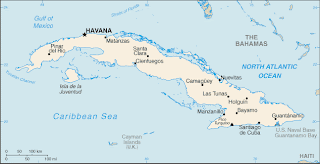The native Amerindian population of Cuba began to decline after the European discovery of the island by Christopher COLUMBUS in 1492 and following its development as a Spanish colony during the next several centuries. Large numbers of African slaves were imported to work the coffee and sugar plantations, and Havana became the launching point for the annual treasure fleets bound for Spain from Mexico and Peru. Spanish rule eventually provoked an independence movement and occasional rebellions that were harshly suppressed. US intervention during the Spanish-American War in 1898 assisted the Cubans in overthrowing Spanish rule. The Treaty of Paris established Cuban independence from the US in 1902 after which the island experienced a string of governments mostly dominated by the military and corrupt politicians. Fidel CASTRO led a rebel army to victory in 1959; his iron rule held the subsequent regime together for nearly five decades. He stepped down as president in February 2008 in favor of his younger brother Raul CASTRO. Cuba's communist revolution, with Soviet support, was exported throughout Latin America and Africa during the 1960s, 1970s, and 1980s. The country faced a severe economic downturn in 1990 following the withdrawal of former Soviet subsidies worth $4 billion to $6 billion annually. Cuba at times portrays the US embargo, in place since 1961, as the source if its difficulties. Illicit migration to the US - using homemade rafts, alien smugglers, air flights, or via the US's southwest border - is a continuing problem. The US Coast Guard interdicted 1,275 Cuban nationals attempting to cross the Straits of Florida in 2012.With an area of 110,860 sq km, it is slightly smaller than the U.S. state of Pennsylvania.
CIA World Factbook
Cuba shares a border with the U.S. Naval Base at Guantanamo Bay. The Guantanamo Naval Base has an area of 29 km. It is leased by the US and remains part of Cuba. It is mostly flat to rolling plains, with rugged hills and mountains in the southeast.
People who live in Cuba are called Cubans, which is also an adjective used to describe something from this country. As of July 2013, there are 11,061,886 people in Cuba. The ethnic groups that reside in Cuba are mostly white (65.1%), with some mulatto and mestizo (24.8%) and black (10.1%). The official language of Cuba is Spanish. Roman Catholicism makes up approximately 85% of the population, while Protestant, Jehovah's Witnesses, Jewish, and Santeri make up the rest.
The country's official name is the Republic of Cuba. The capital is Havana, and the country is made up of 15 provinces. Cuba gained independence from Spain on May 20, 1902. A constitution was drafted in 1976. The constitution can be found here through Constitution Finder. The current president and Council of State is Raul Modesto Castro Ruz. Information about the leaders of Cuba's government can be found here. The currency is the Cuban pesos (abbreviated CUP), which stands at 1 CUP per USD as of 2012.
All of this information was gathered from the CIA World Factbook. For more information, check out these resources...
Cuba, CIA World Factbook
Cuba, U.S. Department of State
2012 Country Report on Human Rights Practices in Cuba, U.S. Department of State.
You can also check out the Country Studies tab on our Fed Docs libguide here for more resources on all of the countries.
Sonnet Ireland
Head of Federal Documents, Microforms, & Analog Media
Reference & Instruction Librarian
Liaison Librarian:
Hotel, Restaurant, and Tourism;
Law; Management; Marketing


No comments:
Post a Comment